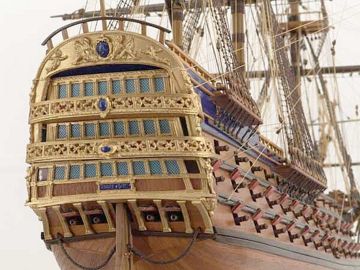Ship Of The Line
 From Conservapedia
From Conservapedia During the age of sail, a ship of the line was a warship of sufficient fire-power to engage in the line of battle. It was replaced in the mid-19th century by the steam-powered Battleship, which was much faster and more maneuverable.
During the Anglo-Dutch wars of the second half of the 17th century naval tacticians, aware that as a floating artillery battery a warship was far more effective when it was side-on to the enemy and could fire all the guns along one side of the ship - a “broadside” - and that the more ships that could be side-on to the enemy at a given time, the more weight of shot could be sent across the intervening water, began developing controlled squadron formations to facilitate this. Up until then naval battles had tended to be free-for-alls - sort of nautical melees. From this time, until the introduction of “over the horizon” artillery and development of the aircraft carrier in the 20th century, the line of battle was the way to go.
The ship of the line became the ultimate naval fighting unit during the 18th and early 19th centuries. It was a two- or three-decker carrying between 64 and 130 guns firing 24 and 32 pound shot, often at point-blank range. The ship's size was not just to maximise its use as a stable as possible gun platform, but to allow it to absorb the fire from an enemy as powerful as itself.
From the middle of the 18th century, warships of the era were “rated” according to the number of guns – from 1 to 6. About 1800, a “first-rater” carried over 100 guns, employed between 850 and 900 crew and had a displacement weight of over 2000 tons. (Nelson’s “Victory” (103 guns) is the most famous of this class.) A “second-rater” carried 84 to 90 and a “third-rater” 64 to 80. The smaller classes rated the frigates and other support vessels that were considered not powerful enough to be in the line of battle. (Attempts were made to design a large 60 gun frigate for this use, but whilst effective in smaller fleet actions they failed in major engagements.) In 1810, 110 guns became the lower limit for a “first-rater”.
These vessels – the so-called “wooden walls” - defended Britain during the various wars of the 18th and early 19th centuries, and on two occasions saved the country from imminent invasion. (See Battle of Quiberon Bay (1759) and Trafalgar (1805).) Whilst it was generally considered that French ships were superior, British discipline, resulting in a greater rate of fire, and seamanship led to very few defeats in major naval engagements during this period.
The last major engagement between wooden-hulled sailing ships was the Battle of Navarino between Britain and Turkey in 1827 during the Greek War of Independence. It is notable that the Turkish superiority in number of ships (almost 4 to 1) and guns (almost double) was negated by Britain's 10 ships of the line to Turkey's 3.
Further reading[edit]
- Nicholas Blake. Steering to Glory: A Day in the Life of a Ship of the Line (2006)
- Angus Konstam and Tony Bryan. British Napoleonic Ship-of-the-Line (2001), well illustrated except and text search
- Brian Lavery. The Ship of the Line, Vol. 1: The Development of the Battlefleet 1650-1850 (2004)
- Brian Lavery. Ship of the Line, Vol. 2: Design, Construction and Fittings (1998)
See also[edit]
- Battleship
- Frigate
- Naval warfare
- Naval guns
- Battle of Trafalgar great British victory in 1805
Categories: [Warships] [Sailing Ship Types] [Naval History]
↧ Download as ZWI file | Last modified: 02/23/2023 22:05:07 | 11 views
☰ Source: https://www.conservapedia.com/Ship_of_the_line | License: CC BY-SA 3.0
 ZWI signed:
ZWI signed:

 KSF
KSF